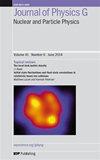核壳模型中的质子-中子纠缠
IF 3.4
3区 物理与天体物理
Q2 PHYSICS, NUCLEAR
Journal of Physics G: Nuclear and Particle Physics
Pub Date : 2022-10-25
DOI:10.1088/1361-6471/acbece
引用次数: 12
摘要
我们计算了各种核素和相互作用的相互作用核壳模型中的质子-中子纠缠熵。一些{结果}具有直观意义,例如,由单粒子和单极子能量控制的壳层结构强烈影响能量可用空间,从而影响纠缠熵。我们还发现了一个令人惊讶的结果:当$N\neqZ$时,核素在低激发能下的纠缠熵趋于减小。虽然我们{提供证据}这是由物理核力产生的{通过与没有显示出这种减少的随机两体相互作用进行对比},但确切的机制尚不清楚。尽管如此,低纠缠度表明,在富含中子的核素模型中,质子和中子之间的耦合可能比人们预期的计算要求更低。本文章由计算机程序翻译,如有差异,请以英文原文为准。
Proton-neutron entanglement in the nuclear shell model
We compute the proton-neutron entanglement entropy in the interacting nuclear shell model for a variety of nuclides and interactions. Some { results} make intuitive sense, for example that the shell structure, as governed by single-particle and monopole energies, strongly affects the energetically available space and thus the entanglement entropy. We also find a surprising result: that the entanglement entropy at low excitation energy tends to decrease for nuclides when $N \neq Z$. While we { provide evidence} this arises from the physical nuclear force { by contrasting with random two-body interactions which shows no such decrease}, the exact mechanism is unclear. Nonetheless, the low entanglement suggests that in models of neutron-rich nuclides, the coupling between protons and neutrons may be less computationally demanding than one might otherwise expect.
求助全文
通过发布文献求助,成功后即可免费获取论文全文。
去求助
来源期刊
CiteScore
7.60
自引率
5.70%
发文量
105
审稿时长
1 months
期刊介绍:
Journal of Physics G: Nuclear and Particle Physics (JPhysG) publishes articles on theoretical and experimental topics in all areas of nuclear and particle physics, including nuclear and particle astrophysics. The journal welcomes submissions from any interface area between these fields.
All aspects of fundamental nuclear physics research, including:
nuclear forces and few-body systems;
nuclear structure and nuclear reactions;
rare decays and fundamental symmetries;
hadronic physics, lattice QCD;
heavy-ion physics;
hot and dense matter, QCD phase diagram.
All aspects of elementary particle physics research, including:
high-energy particle physics;
neutrino physics;
phenomenology and theory;
beyond standard model physics;
electroweak interactions;
fundamental symmetries.
All aspects of nuclear and particle astrophysics including:
nuclear physics of stars and stellar explosions;
nucleosynthesis;
nuclear equation of state;
astrophysical neutrino physics;
cosmic rays;
dark matter.
JPhysG publishes a variety of article types for the community. As well as high-quality research papers, this includes our prestigious topical review series, focus issues, and the rapid publication of letters.

 求助内容:
求助内容: 应助结果提醒方式:
应助结果提醒方式:


